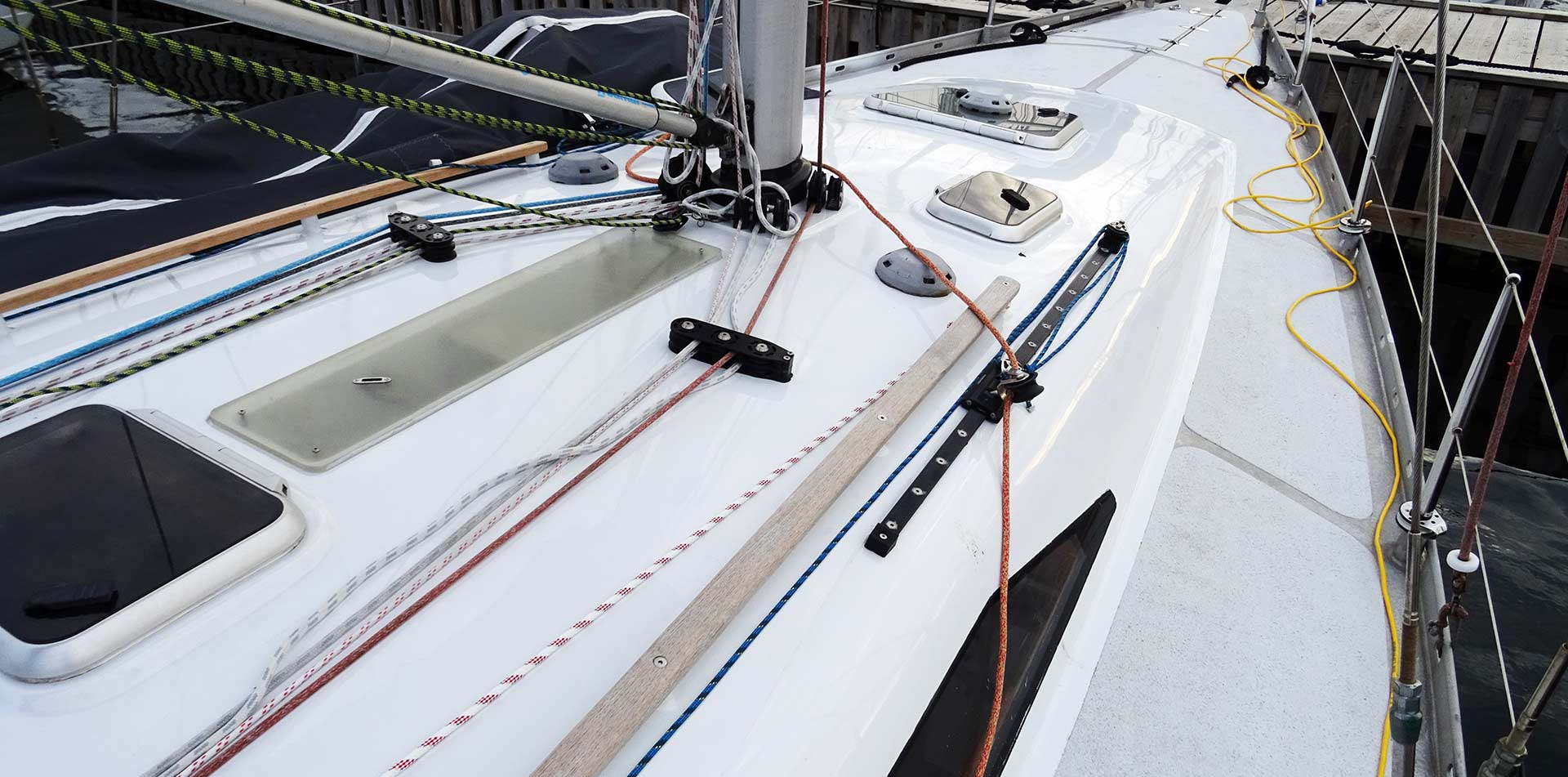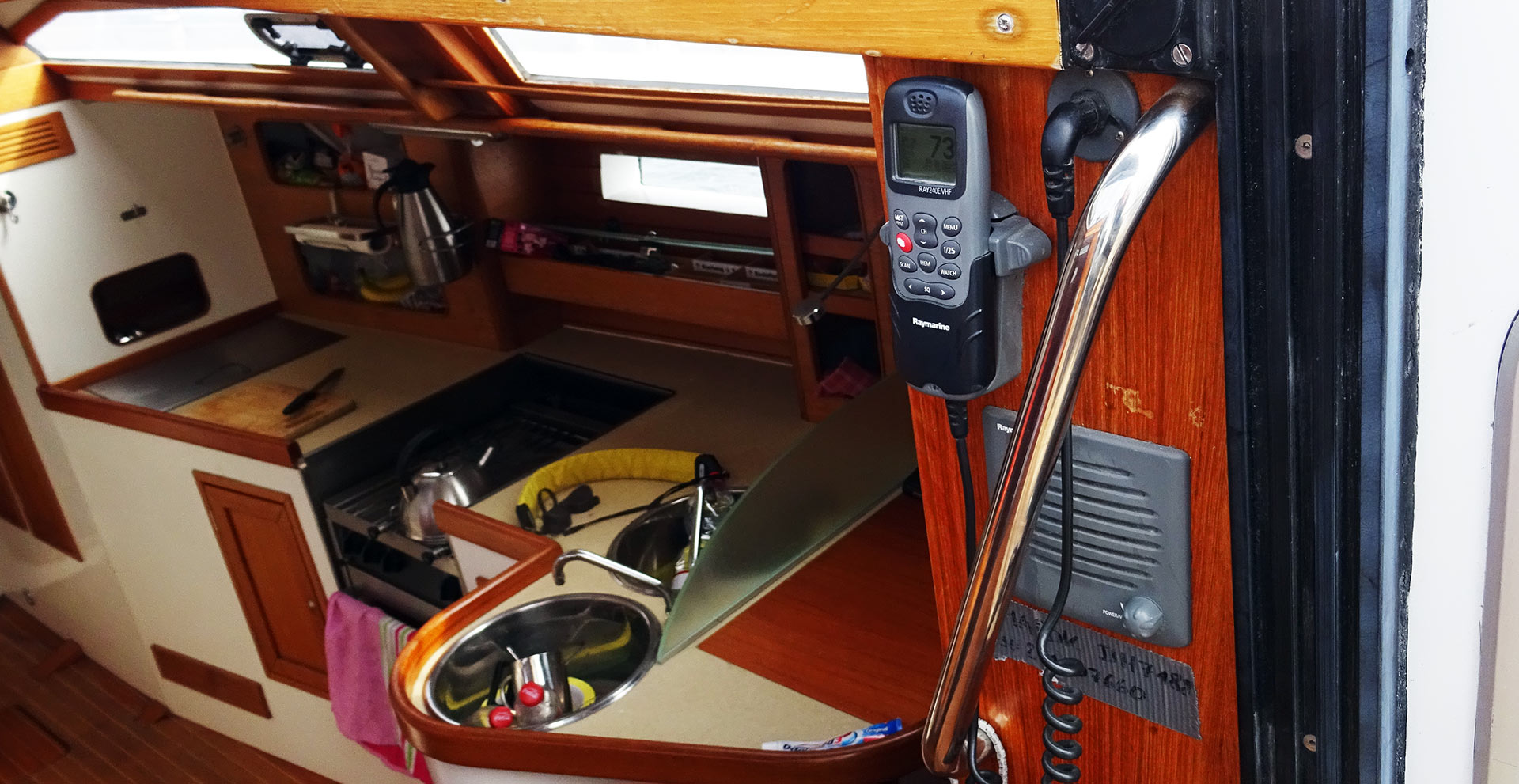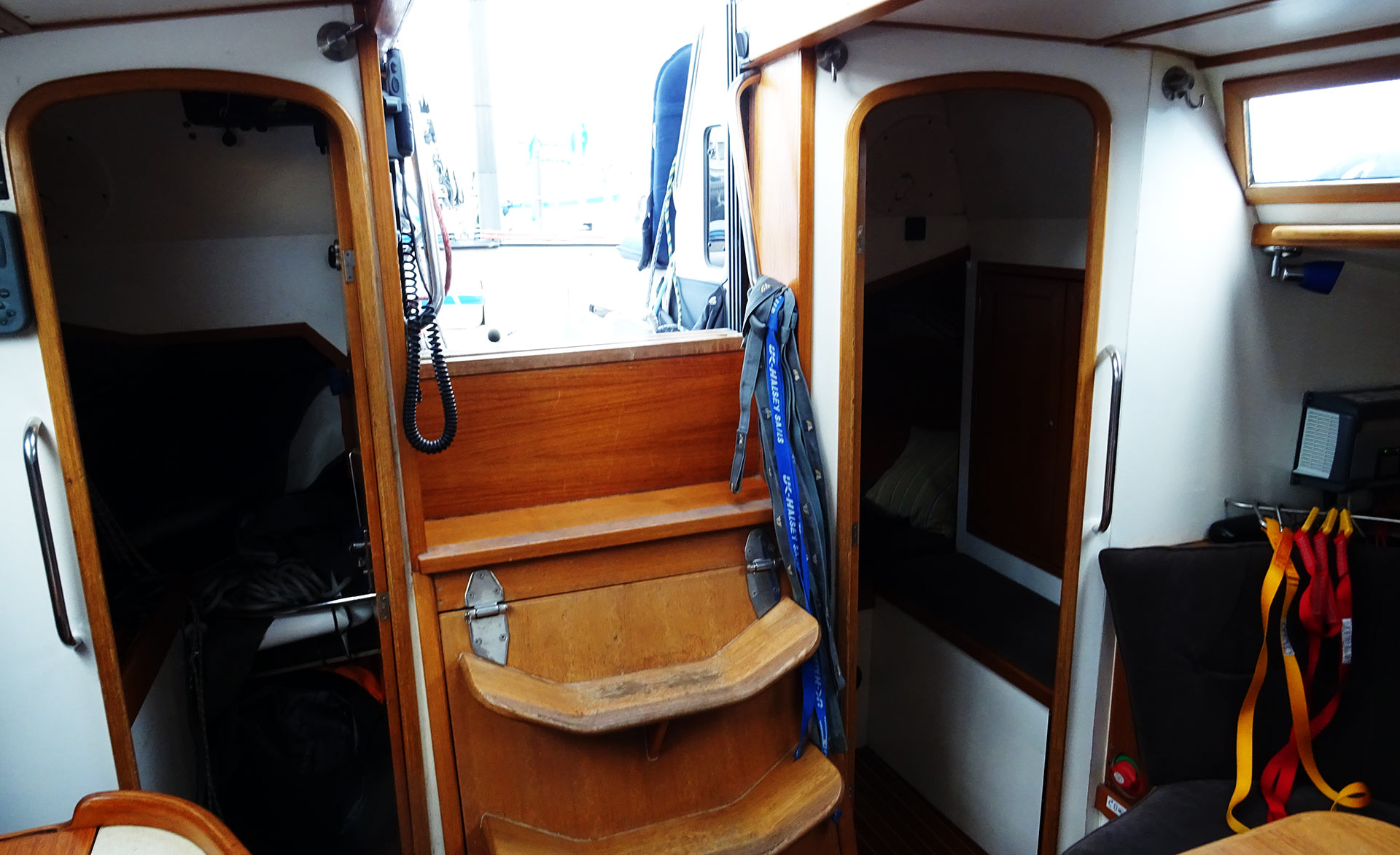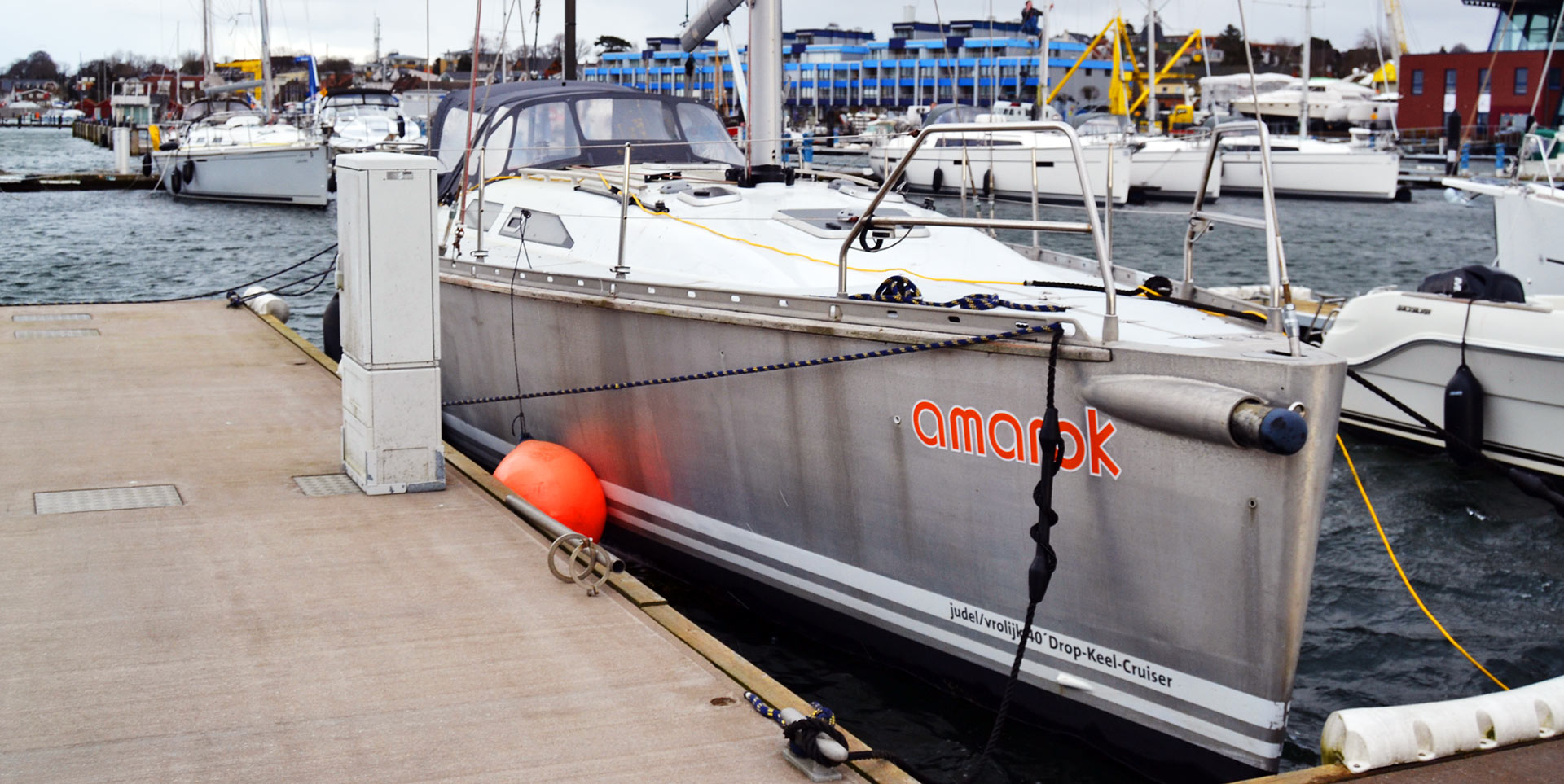Looking back on each and every of my sailing boat trips so far, there are some voyages which are really standing out. Some are because of the duration, like my Atlantic sailing trip from Lisbon to the Canary Islands, some because of special circumstances, like my first ever trip as skipper and some because of external factors, like my first ever real foul weather sailing trip. In this matter, there will be another sailing voyage added – my first ever sailed miles aboard an aluminium yacht. Why? Because this was such a special sailing experience!

I´ve made just over 600 miles in SY AMAROK last week (read the full article on this sailing trip here) and I´d like to share my experience yacht-wise with you because I feel that this is something really special, something so much different from sailing on a GRP-boat that this might be of interest for you. So, the first fact is this: AMAROK is an aluminium built sailing yacht, a Judel/Vrolijk design built in 2003 by renown yard Benjamins in Emden (which I had the pleasure to visit a couple of months ago). The boat itself has a length over all of 13 metres, a max beam of 3.32 metres and her displacement is some 8.5 tons. It is a cruiser made to sail fast – and fast she sails indeed!

I was given the boat by her owner, Matthias, whom I got to know after having inspected his new project, a Berckemeyer 49 Pilot House – also a marvel – and as I was so much humbled by his move and couldn´t barely find words to express my gratitude, he just said: “I am happy for you to go out and sail her, and I am much more happier for the boat to be sailed now.” And, as I said, this boat wants to be sailed. She is a mile-eater, and she does eat the miles fast. The indicator most of the time stayed well above 6 knots, mostly around 7.5 to 8.5 easily knots no matter which point of sail we were on, max speed during my sailing experience with her was 9.4 knots SOG upwind.
A drop keel yacht
Her main feature – although not really utilized on my first trip with her – is that she has a variable draft. The massive drop keel (a straight fin with a massive lead bulb attached) is moved hydraulically and thus reducing the draft of 2.40 metres down to just 1.20 metres. The boat than can fall dry or, which is best about it, can enter very shallow anchorages or harbours which normally wouldn´t be accessible. Raising and extending the keel to the full extend will last under a minute and is done effortless by the hydraulic system.

Which brings me shortly to the electric system of AMAROK: She has three main batteries: One battery set for general consumption, one starter battery for the engine (which is a flawlessly operating 38 hP Nanni Diesel) and of course one battery for operating the hydraulic system. All of them are loaded automatically and controlled by a huge Philippi charge controlling unit. As the boat is made from aluminium, a lot of effort went into proper installation and massless connection of all wiring in the boat. We didn´t have had the smallest issue with the boat´s electric system.
No frills sailing: Rigg and roping on AMAROK
Matthias is a sailor through and through and in it a no-frills-skipper par excellence. He follows his own rules and one is: “Things with a cable attached will certainly fail some time.” So everything of the boat´s equipment has been carefully chosen by him to fit his no-frills-sailing approach. Let´s start with the sails: There is no furling system for the jib. Let´s repeat: No furling jib. As the boat bears 85 square metres of upwind sail area, a large portion of this is the fore sail.

The sail is connected the old-fashioned way by massive runner ties to the fore stay and is hoisted by the jib halyard and pure man power. In this, it is absolutely pure sailing. Of course, there is no way for reefing this sail. Matthias assured me that he is sailing the full jib in winds up to 30 knots (then of couse with the main completely down) and we have sailed the jib in winds of 28 knots in gusts, and I can say: The boat is doing just fine, there is no excessive heel whatsoever and the speed is absolutely fantastic! Well, on the other hand, taking down the jib requires a man in the bow which is quite a nice ride when having her nose put dead in the wind and the boat jumping up and down in strong windy conditions, but I guess that´s pure sailing. Same applies to the main: But this sail is operated completely from the cockpit with 2 reefs being put in with 2 lines each. She is a powerful boat though, her sailplan carefully chosen to propel her as fast as possible on every point of sail.

As she is meant to be a no-frills-boat, her mainsheet is pure and simple: There is a large traveller mounted across all of the cockpit´s width in the aft section of it. The mainsheet itself is a never-ending rope on two massive jammers – that´s like sailing a jollyboat. The mainsheet is running over a large pulley making it so easy to trim the main directly from one´s hand without having to crank a winch. The downside to this is the limiting of available cockpit space – but AMAROK was never conceived to be a maritime chillout zone with a maximum cockpit volume to host parties, sundowners and dinner, she is a sailing machine.

Speaking of winches: No frills does not really apply to her set of winches as her owner decided to go for the best available equipment in this respect. The Danish made Andersen winches do not only look awesome but are the crème de la crème when it comes to the cranking action. Andersen is something special: As the reel cylinder itself (like the rest of the winch) is made of stainless steel, it takes one or two revelations of the respective rope more than on an ordinary winch to generate enough grip. Once knowing this detail, there is much fun in using these.
Steering the boat: Practical details
I must say that on AMAROK everything, just everything, every tiny detail on the boat is subdued to the dictum of practicality. The designers at Judel/Vrolijk but also her owner had done a magnificent job to fit the boat very much a sailing tool made for long haul sailing trips. Everything on this boat makes perfect sense. Just look at the chart plotter. It´s not the latest fancy stuff of touch-screen equipment but it works perfectly and is doing what it is supposed to do just fine. The detail is the solid stainless handle just right of the display – it´s a fantastic idea!

When working on the plotter in heavy swell and foul weather, one can hold to the small rail whilst turning the wheel or pushing the button. On the other hand, pushing buttons by accident is impossible because of the small handrail. That´s a nice detail though! Another small, but great thing, is the location of the VHF – it has been mounted just upstairs the entryway down to the salon. That is a perfect position as one can work on the VHF very nicely while in the cockpit (there is a second speaker for turning up volume) and whilst down in the salon because it is mounted in standing height just next to the nav station. Nice!

I also loved the gauges on AMAROK. So clever, so fail-safe, so practical: The 135 litres of Diesel and 270 litres of fresh water (in stainless steel tanks) are gauged by a simple small transparent pipe with a scale next to it. A simple system that does not need a swimmer or electric sensor. It can never fail or show false data (well, don´t trust the tankage when heeled …). And besides, it is beautiful in its own way, I would say.

I love all these small little tricks and wizards which make the AMAROK a very special boat: It is the first boat I was ever sailing with where I truly – no, please believe me – truly hadn´t any issues with whatsoever. Everything is in the right place, it has the right size and works out just fine. Nothing is oversized, nothing is underdesigned nor has it faults in any way. For example the whole steering of the boat, it is a fine example of the true architecture of the boat, let´s have a thorough look.
Steering the boat #2 – The Rudder
From afar the yacht has an impressive appearance. Partially because of the martial impression that comes naturally with the material aluminium that is responsible for the battleship-like looks of the yacht. On the other hand it comes from the massive and solid rudder of SY AMAROK. The single rudder blade is as simple as it can get: A tiller-steered blade held by a massive stainless steel construction. Once situated behind the steering – that is a classic, unbalanced blade – one feels the solid weight of the craftsmanship. With the whole ship itself one feels instantly safe and assured by the solidity of the construction.

The rudder-blade is secured by four thick screws to the tiller. If needed, one can loosen the screws and fix a pulley to the upper side of the blade. The pulley itself is fixed to the backstay – a few strokes and the rudder will glide upward within the tiller-construction. With this simple by effective technique the draft of the boat can be reduced along with the keel. We didn´t checked the functioning of this mechanism out (as we didn´t wanted to overstress the boat´s composure on our first trip in her) but had a thorough look. It´s simple. It´s effective. It is no-frills.

Of course, because of the heavy weight of the material and the fact that the rudder is unbalanced, it takes a load of musclepower to steer by hand. I sensed steering the boat by hand whilst sailing wasn´t that hard since the forward motion of the yacht was helping to counter the weight, but hard rudder or steering whilst under engine power took much more. When going backwards with engine astern (the boat responded just fine) one needed to hold very, very tight to the rudder in order to prevent it from sliding out of one´s hand. Most of the time we´ve had the rudder attached to the self steering system.

That is a very powerful machine aboard AMAROK and I would say it is the most important part of the technical equipment here. I learned how convenient it was to have a good automatic steering system during my Atlantic voyage last year, but even more so I learned that having a strong, capable self steering is worth gold. With AMAROK, the autopilot did a marvellous job indeed. We sailed constantly with the machine working the rudder (even in strong and windy conditions) for up to 10 hours with our batteries barely emptied. Love this piece!
Inside AMAROK
The boat´s interior is very ship-like and resembles what ship building used to be before the large production boat companies modernized techniques and introduced modules. If you go on a contemporary sailing yacht nowadays, you´ll instantly notice that somehow the interior carpentry looks detached from the shapes of the boat. That is because of the production methods: Heads, galleys, cabins and salons are made outside of the hull as complete modules, pulled in by a crane before the deck structure is applied and the boat closed. It´s different in AMAROK.

In AMAROK every piece of joinery has been tailor made for the boat. Has been brought down into a fully completed hull and assembled down here. That is, by the way, one of the reasons why aluminium boats are much more expensive than GRP boats – the much higher complexity and labor-intensive work that is the interior fitting. When coming down the ladder into AMAROKs internals, there are two doors to either side of the stern section. Starboard leads to a workshop-cabin (which is also fitted with a makeshift berth), port side leads to a proper aft cabin, which was mine during the trip.

The aft cabin offers a huge berth! The bed leads way up down under the cockpit and over the longitudinal axis of the boat. Two adults will find more than enough space here to find a good night´s sleep. There is also a large locker with cupboards and a shelf for smaller things. USB-charging devices are mounted in every cabin and in the salon of course, two opening portlights to the cockpit will make for fresh air. There is no portlight window in the hull, which would be a must have for my boat, should I ever get to the point having one build for me.

Standing in the salon, the massive keel house right behind the keel-steeped mast (which is in the central head) makes for the partition of the galley, head and salon. I loved the simple white lacquered surfaces with wooden decorative stripes, paired with ceilings of wood. This makes the boat very, very bright although there honestly aren´t too many opening windows or portholes which could let natural light inside the boat.

The salon is a large, very cosy, U-shaped settee that will have six persons seated. We found two holes in the floorboard which could be an indication for mounting a stool of some sort facing the settee, but I didn´t ask the owner about this feature as we were just two person sailing this yacht anyway. Again, it is very comfortable sitting here, having a late dinner or the hot morning coffee in case it´s foul weather outside. I was especially fond of the gas lamp (right until I checked the price tag on this beauty …)

You know that I love cooking aboard and that’s why I´ve spent a lot of time in the ship´s galley. Again, everything is subordinated the dictum of practicality. The water-system of AMAROK works solely on muscle power: By stepping on a foot pump the fresh water (either cold or hot, when engine was running) will flow into one of the two sinks. There is of course also a salt water pump. The gimballed stove works just fine, I was particularly impressed with the remote de-energization system directly at the valve. It is so much safer than the standard on yachts: Again, on my future boat this would be a must-have for sure! The fridge was huge and after one night running we had the goods ice-cold during a sailing day without having the fridge running on precious battery-power. To the far left side of the galley lots and lots and lots of storage for provisions was to be found. Perfect!

Somehow integrated into the galley on starboard side, where it belongs, the navigation station with the main switchboard of the yacht. The chart table was small, simple but sufficient for every task I needed it. Sitting in the small bench doing my log and re-charting our efforts after a good day of sailing was one of the most appreciated tasks of the trip. It was so nice partially because of the high quality of the seating cushion which also made it very, very nice to be seated on the settee.

By the way, another nice detail: Massive grab handles almost everywhere! Again, this is also something that somehow seems to have gotten lost on most modern production cruisers. It is absolutely essential and a question of safety to have solid, big grab handles and rails both on and below decks to hold tight when the boat is heeling or working hard in waves. On AMAROK there was never a situation when I missed a grab somewhere. Exemplary again. Oh, and I didn´t take a picture of the large owner´s cabin because my sailing mate did spread his stuff in the cabin to an extent that it would get this sailing blog rated … so, no pic of this, but believe me, the cabin is very, very big for a 40 footer.
Aluminium sailing yacht? Anytime again!
The AMAROK is a dream yacht of mine in every respect. I love her design, I love her simplicity and practicality and I love her sailing characteristics. She is a damn fast boat! The SOG never ever drops under 6 knots when wind speed is over 10 knots. Upwind we´ve had her as fast as up to 8.something and max speed during our trip was 9.4 knots on a reaching point of sail. She is a dream to sail with.

What was the most impressive feature of this yacht – and I guess it simply comes because of the material aluminium – was her quietness. There was no squeak whatsoever in the floorboards, the bulkheads or the rigg. There was no clatter, no banging, no vibration simply no nothing to be heard whatsoever, even when we hit a wave upfront with full speed and the boat dashed down into the water at the wave´s back end. Nothing! Just a quiet, nice seakind motion. I couldn´t believe how silent a boat can sail! Just wow!

In the end, sailing the two weeks on AMAROK convinced me of the superiority of aluminium as the material of choice for yachts. When we were mooring the boat in harbours – although of course we tried (and managed to succeed) not to hit anything nor anybody else, it is simply a big faith and trust in the material. When you love the harsh rough looks of aluminium, you definitely should go for a boat made of this alloy. We said Goodbye to the boat and wished her well – knowing that she definitely will do well in all of her future journeys. A true ship for true sailors. What a great boat!
By the way: AMAROK is up for sale: Please browse the website www.sy-amarok.de and contact the owner Matthias for full specs, price and details.
Like aluminium sailing yachts? Check out these articles:
Berckemeyer Yachts in the making: A yard-visit in Emden
Moitessier reloaded – aboard an aluminium Trisbal
Visiting Alubat in France: Where the Ovni and the Cigale is born
